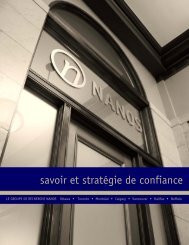Future of the Gardiner Expressway - Nanos Research
Future of the Gardiner Expressway - Nanos Research
Future of the Gardiner Expressway - Nanos Research
Create successful ePaper yourself
Turn your PDF publications into a flip-book with our unique Google optimized e-Paper software.
The Governor announced in early 2009that <strong>the</strong> viaduct will be replaced by deepbored tunnel under downtown Seattle. Thisalternative was not evaluated in <strong>the</strong> EIS. Costfor <strong>the</strong> bored tunnel is estimated at US $4.24billion.Urban DesignThe Alaskan Way Viaduct, in particularbecause it is a double-decker structure,is thought to reduce <strong>the</strong> quality <strong>of</strong> <strong>the</strong>downtown environment and potential portareadevelopment value. Its visual impact onSteinbreuk Park is especially felt, since thisopen space is symbolically important to bothdowntown and <strong>the</strong> city.Most land in <strong>the</strong> downtown waterfront areais privately-owned. While some developmentparcels will be created, <strong>the</strong> City <strong>of</strong> Seattledoes not stand to significantly re-capturepublic investment value through landdisposition. Direct economic benefits to <strong>the</strong>City would come through increased tourismand rising property values.The viaduct also poses a sharp environmentalchallenge to Seattle – maintaining currenttraffic volumes on <strong>the</strong> viaduct will likelyexceed state carbon reduction goals, some <strong>of</strong><strong>the</strong> most ambitious in <strong>the</strong> U.S.The study’s urban design objectives weremostly related to existing waterfront land useplans. Pedestrian and bicycle access werekey goals, as well enhanced waterfront andmountain views. All alternatives studied howto create waterfront pedestrian realm andwhe<strong>the</strong>r bringing <strong>the</strong> viaduct to grade might,in fact, diminish existing pedestrian realm.The viaduct is an aging infrastructure. For thisreason, safety and design deficiencies – forexample, 3-meter-wide (10 feet) lanes – werekey concerns. Yet transportation strategiesrevolved around a key question. Shouldviaduct redesign accommodate existing trafficvolumes – 110,000 vehicles per day – orencourage mode shift?Existing condition under <strong>the</strong> Viaduct.Rendering <strong>of</strong> proposed condition.Alaskan Way Viaduct Section – After (Proposed)SECTION V: Case studies 21



